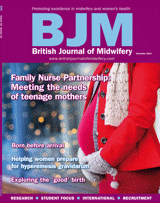At the moment a baby is born, about a third of its blood is outside of its body. Physiological studies have shown that, of the total blood volume in the combined fetal–placental circulation at full gestation, approximately 25–60% is found in the placental circulation. This blood is known to be rich in hematopoietic stem cells (Wardrop and Holland, 1995; Dixon, 1997).
The optimal timing of cord clamping has been a controversial issue for decades. For many years, it was advised that the cord was cut immediately following birth. However, the World Health Organization (WHO, 2012) no longer recommends this because a delay in clamping the cord allows continued passage of blood from the placenta to the baby for an additional 1 to 3 minutes after birth. This brief delay could help prevent iron deficiency from developing before 6 months of age in babies born at full term (Chaparro et al, 2006). Despite that, most practitioners in Western countries clamp and cut cord immediately after birth (Mercer, 2001). Early cord clamping, compared with delayed clamping, has no beneficial evidence-base. There is, however, credible evidence that it results in a decrease to the neonate of 20–40 mL of blood per kilogram of body weight, which would provide the equivalent of 30 to 35 mg of iron (Hutton and Hassan, 2007). Resulting in a subsequent decrease in oxygen and stem cells.
Oestergaard et al's (2011) systematic evaluation estimated that 23% of all newborn deaths around the world are caused by asphyxia. And that is just a fraction of a problem. Iron deficiency anaemia is one of the world's biggest public health problems and a leading cause of infant morbidity and mortality worldwide (WHO, 2000). Moderate anaemia has been consistently shown to be associated with depressed mental and motor development in children. Longitudinal studies have indicated that children who were anaemic in early childhood continue to have poor cognitive and motor development and are often left with lifelong consequences such as epilepsy or learning disability (Lozzoff et al, 2000; Georgieff, 2011). Perhaps the most important finding here is the possible effects of early cord clamping extending way beyond the early neonatal period.
Delayed or optimal cord clamping has been suggested as a measure to prevent infant iron deficiency. The ‘Ticc Tocc’ campaign introduced by Dr Alan Greene suggests the transition from immediate cord clamping to the optimum cord clamping. It recommends waiting an extra 90 seconds after birth until the umbilical cord stops actively pulsating and pumping fetal blood into the baby, unless there is a strong reason otherwise.
Delayed cord clamping can transform the lives of children around the world. This idea is simple, easy to implement, the cost is little or nothing and makes all other interventions more effective. All it requires is health professionals join together to accomplish it. A more liberal approach to delaying clamping of the umbilical cord in healthy term infants appears to be justified, particularly in light of growing evidence that delayed cord clamping may be of benefit in the longer-term in preventing anaemia and promoting better iron stores. This has been studied in countries such as Argentina, Australia, Bangladesh, Canada, India, Libya, Mexico, Pakistan, United Kingdom, USA and Zambia. Optimal cord clamping has been shown to be safe and effective at significantly reducing the risk of iron deficiency (Mercer and Erickson-Owens, 2006).
‘More than a quarter million babies will be born today. The clock is ticking’ (Greene, 2012).


